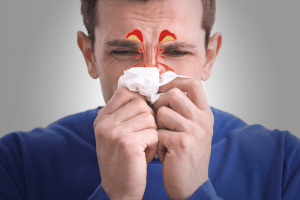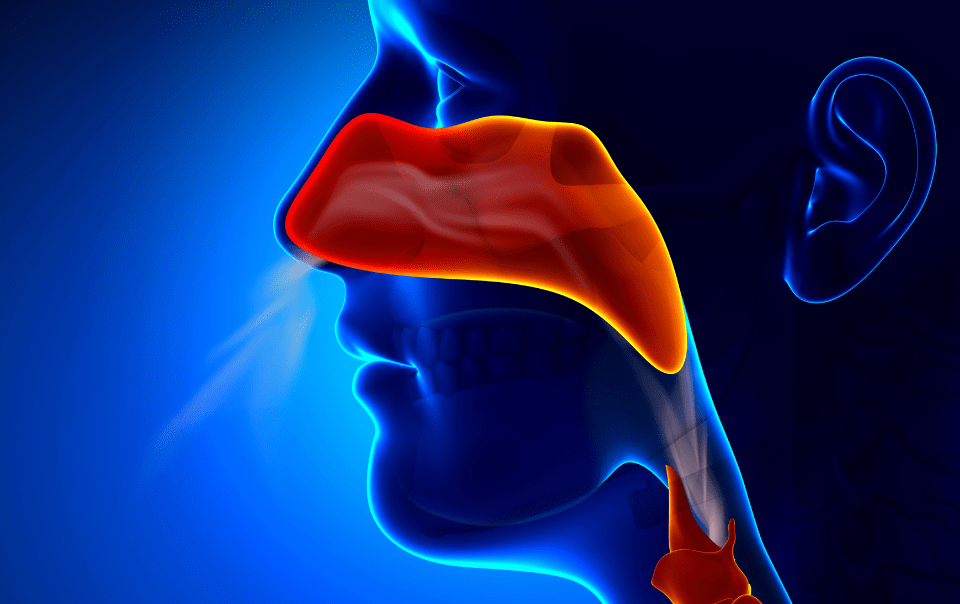Concha bullosa occurs when one of the nasal turbinates—usually the middle turbinate—becomes enlarged due to an air-filled pocket or cyst within it. The turbinates are curved bones within the nasal cavity covered by soft tissue, and they play a key role in regulating airflow and humidity. When a concha bullosa develops, it can cause nasal obstruction, congestion, and discomfort.
Continue reading to learn more about this condition and when you should see a sinus doctor in Los Angeles.
Understanding Concha Bullosa
A concha bullosa is essentially a bubble or hollow area within the middle turbinate. While concha bullosa can occur in any of the nasal turbinates, it most commonly affects the middle one. The exact cause of concha bullosa is unknown, but it is often present at birth and may enlarge over time.
When the concha bullosa grows, it can block the nasal passages, leading to breathing difficulties. This condition can also contribute to sinus issues because it obstructs the normal drainage of the sinuses, allowing mucus to accumulate. As a result, many people with a concha bullosa may experience recurring sinus infections and other related symptoms.
Common Symptoms of Concha Bullosa
While concha bullosa doesn’t always cause symptoms, it can be problematic when it becomes large enough to block airflow or interfere with sinus drainage. Some common symptoms include:
- Nasal Obstruction: Many people with concha bullosa feel like their nose is always partially or fully blocked, making it difficult to breathe through the affected nostril.
- Chronic Nasal Congestion: The obstruction often leads to a feeling of congestion or stuffiness, similar to what you might feel during a cold or allergies.
- Recurrent Sinus Infections: Due to poor drainage, individuals with concha bullosa may experience recurring sinus infections, often with symptoms like facial pain, pressure, and thick mucus.
- Facial Pain or Pressure: Blocked sinuses can lead to feelings of pressure or dull pain in the forehead, cheeks, or between the eyes.
- Headaches: Pressure caused by obstructed sinuses can sometimes lead to persistent or recurring headaches.
- Reduced Sense of Smell: In severe cases, a blocked nasal passage can diminish your ability to smell.
These symptoms can vary based on the severity of the concha bullosa and whether it affects one or both sides of the nasal cavity.
Diagnosing Concha Bullosa
If you’re experiencing symptoms that suggest a concha bullosa, such as chronic nasal congestion or recurring sinus infections, a visit to sinus doctor in Los Angeles can help with diagnosis. The sinus specialist will take a thorough history of your symptoms and may use a few different methods to diagnose concha bullosa:
- Nasal Endoscopy: This procedure involves inserting a small, flexible camera into the nasal passages to get a closer look at the nasal cavity and check for any abnormalities, including concha bullosa.
- CT Scan: A CT scan provides detailed images of the nasal structures and sinuses, allowing the sinus doctor to see if there’s an air-filled pocket in the turbinate.
These diagnostic tools help confirm whether concha bullosa is the cause of your symptoms or if other conditions, like a deviated septum or nasal polyps, may be contributing to your nasal obstruction and sinus issues.
Treatment Options for Concha Bullosa
Treatment for concha bullosa depends on the severity of your symptoms. In cases where the concha bullosa isn’t causing significant discomfort or obstruction, treatment may not be necessary. However, if you’re experiencing ongoing symptoms, there are several treatment options available:
Medication Management
- Nasal Decongestants: Over-the-counter or prescription nasal decongestants can reduce swelling in the nasal passages, temporarily easing congestion and improving airflow.
- Nasal Corticosteroids: These medications can help reduce inflammation in the nasal passages and relieve congestion.
- Antihistamines: If allergies are contributing to your nasal symptoms, antihistamines can help relieve congestion and prevent further irritation.
While medications can alleviate symptoms, they don’t address the underlying issue of the enlarged turbinate and are generally used as short-term solutions.
Surgical Treatment
In more severe cases where medication isn’t effective, surgery may be recommended to reduce or remove the concha bullosa and improve nasal airflow. The most common surgical procedures for concha bullosa include:
- Turbinate Reduction: During this procedure, the surgeon removes part of the turbinate tissue to make more room in the nasal passage. In cases of concha bullosa, the surgeon may also remove the air-filled pocket within the turbinate to reduce its size.
- Endoscopic Sinus Surgery: This minimally invasive procedure uses an endoscope to access the nasal passages and remove or reduce the concha bullosa. Endoscopic sinus surgery allows for precise removal of the problematic tissue without affecting surrounding areas.
Surgery is generally safe and effective for treating concha bullosa, with most patients experiencing significant relief from their symptoms. Recovery from these procedures is typically quick, and patients can usually return to normal activities within a few days.
Post-Surgical Care and Recovery
After surgery, it’s important to follow your doctor’s instructions carefully to ensure proper healing and prevent complications. Here are some general guidelines for post-surgical care:
- Avoid Strenuous Activities: For the first week, avoid heavy lifting, bending over, or other activities that might increase blood flow to the nasal area.
- Use Saline Rinses: Rinsing the nasal passages with a saline solution can help keep the area clean and promote healing.
- Avoid Blowing Your Nose: Blowing your nose can disrupt healing, so it’s generally advised to avoid this until your doctor gives you the go-ahead.
- Take Prescribed Medications: If your doctor prescribes antibiotics or pain relief, take them as directed to prevent infection and manage discomfort.
Preventing Complications and Managing Symptoms Long-Term

- Manage Allergies: If allergies contribute to nasal inflammation, work with your doctor to develop an allergy management plan, which might include allergy medications or lifestyle adjustments.
- Use a Humidifier: Keeping the air moist can reduce nasal irritation and improve airflow in your nasal passages.
- Practice Good Nasal Hygiene: Regular saline rinses can help keep the nasal passages clear of mucus and other irritants, reducing the risk of blockages.
FAQs About Concha Bullosa
1. Can concha bullosa go away on its own?
Concha bullosa doesn’t typically resolve on its own, especially if it’s large enough to cause symptoms. However, some people have mild cases that don’t cause significant problems and may not require treatment.
2. Is surgery the only option for treating concha bullosa?
Surgery is usually recommended if symptoms are severe or if medication hasn’t been effective. For mild cases, medications like nasal decongestants and corticosteroids can provide relief.
3. How long does it take to recover from concha bullosa surgery?
Most patients recover within a week, though some experience mild discomfort for a few days after surgery. Your doctor will provide specific post-care instructions for a smooth recovery.
4. Can concha bullosa cause sinus infections?
Yes, concha bullosa can obstruct the sinuses, trapping mucus and leading to infections. Treatment can reduce the risk of recurring sinus infections.
5. Does concha bullosa always cause symptoms?
Not always. Some people have a concha bullosa without any noticeable symptoms. It usually only becomes a problem if it obstructs airflow or affects sinus drainage.
Conclusion
Concha bullosa is a common condition that can impact breathing and sinus health if it becomes large enough to block the nasal passages. While medication can relieve symptoms in mild cases, surgical treatment is often the most effective way to address concha bullosa and improve airflow. With the right diagnosis and treatment plan, patients can experience significant relief and a better quality of life.
If you’re experiencing chronic nasal congestion or other symptoms, contact the Southern California Sinus Institute for a consultation with our sinus specialist, Dr. Alen N. Cohen, MD to learn if concha bullosa is the cause and what treatment options are best for your situation.

